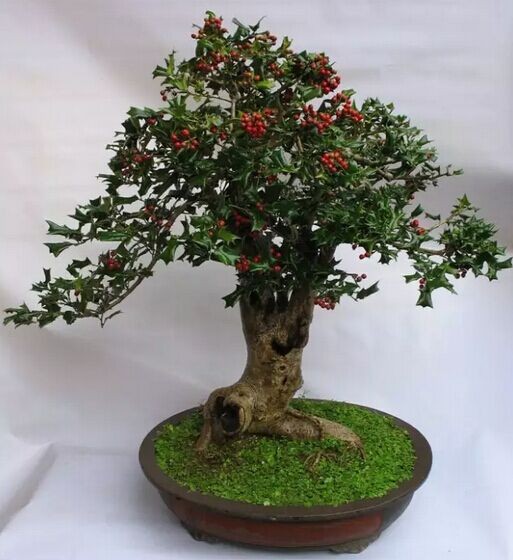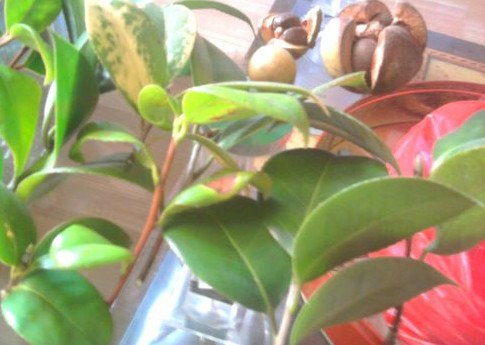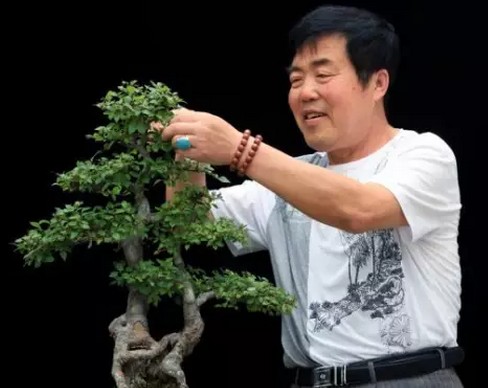Pruning and pose technique of medlar bonsai
"Dog Bone" is Chinese wolfbone, scientific name: Ilex cornuta, also known as cat thorn, tiger thorn, star anise thorn, bird not overnight, dog bone thorn, cat incense, mouse tree, etc., for evergreen shrubs or small trees, strange leaf shape, green light, evergreen four seasons, full branches of red fruit after autumn, not withered by winter, gorgeous and lovely, it is an excellent ornamental leaf and fruit tree species, which is often used in Christmas decoration in Europe and the United States, so it is also called "Christmas tree".

Chinese wolfberry belongs to holly family-holly genus-holly subgenus, native to the middle and lower reaches of the Yangtze River in China, the leaf shape is unique, it is easy to identify in the field.
Tree shape:
Chinese wolfbone is suitable for straight dry type, oblique dry type, curved dry type and cliff type and so on. The branches and leaves of large bonsai can be made into pieces, while the small ones are better made in natural style. Tree stump bonsai should highlight the beauty of exposed roots and dry posture.
Processing:
Chinese wolfberry leaves have sharp thorns, so it is inconvenient to process. Can first cut off all kinds of unnecessary branches and leaves, and then the remaining branches for climbing, and combined with pruning. Because of its large and hard leaves, it is generally not metal wire climbing, but brown wire climbing is better. Processing should be carried out in the rainy season.
Evergreen shrubs or small trees, 1-3 m tall. Young branches with longitudinal ridges and grooves, two-year branches brown, three-year branches gray-white.
Shape:
Leaf blade thickly leathery, dimorphic, quadrangular-oblong or ovate, long 4~9cm, wide 2~4cm, apex with 3 hard spines, central spines often retrorse, base rounded or subtruncate, with 1-2 prickles on each side.
The leaves are dark green, glossy, light green on the back, glabrous on both sides. Primary veins concave above, elevated abaxially, lateral veins 5-6 pairs. Petiole long 4~8mm, with narrow grooves above. Inflorescences clustered in leaf axils of biennial branches.
Fruit globose, 8~10mm in diam., bright red when mature. The flowering period is from April to May and the fruiting period is from October to December.
Time: 2019-06-13 Click:
- Prev

Seed treatment of potted Camellia during sowing
Under the condition of pot culture, especially in the non-origin of camellia, camellia generally bear little fruit, only under the conditions of low degree of single petal or stamen petal, normal pistil development, artificial pollination and suitable temperature and humidity. to get seeds with the ability to germinate. When the capsule is reddish and dehiscent
- Next

Techniques and methods of bonsai pruning
A pot of bonsai stumps with good natural conditions or good natural conditions often grow many new branches. in order to maintain its perfect posture, the bonsai must be often trimmed, otherwise it will gradually lose its hierarchy, resulting in disproportion and tree disorder. Pruning useless branches in time
Related
- Fuxing push coffee new agricultural production and marketing class: lack of small-scale processing plants
- Jujube rice field leisure farm deep ploughing Yilan for five years to create a space for organic food and play
- Nongyu Farm-A trial of organic papaya for brave women with advanced technology
- Four points for attention in the prevention and control of diseases and insect pests of edible fungi
- How to add nutrient solution to Edible Fungi
- Is there any good way to control edible fungus mites?
- Open Inoculation Technology of Edible Fungi
- Is there any clever way to use fertilizer for edible fungus in winter?
- What agents are used to kill the pathogens of edible fungi in the mushroom shed?
- Rapid drying of Edible Fungi

